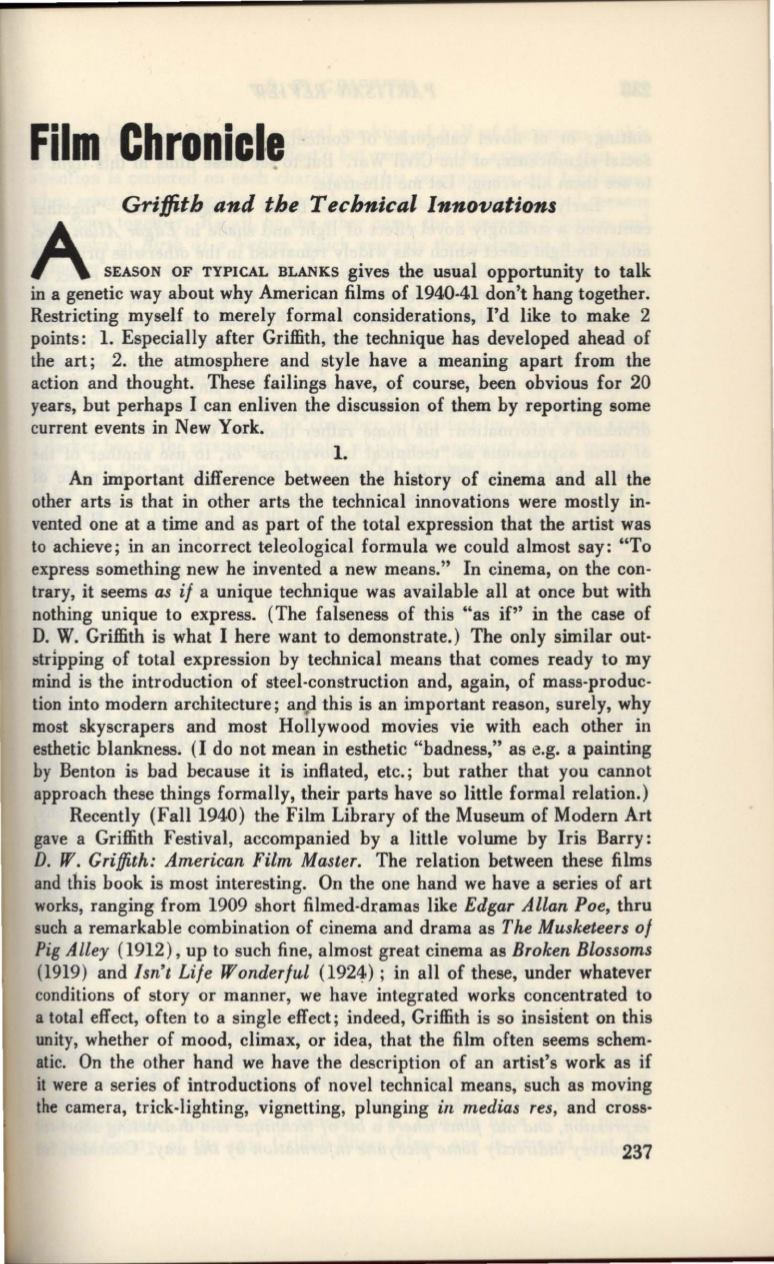
Film Chronicle
Griffith and the Technical Innovations
A
SEASON OF TYPICAL BLANKS
gives the usual opportunity to talk
in a genetic way about why American films of 1940-41 don't hang together.
Restricting myself to merely formal considerations, I'd like to make 2
points:
l.
Especially after Griffith, the technique has developed ahead of
the art; 2. the atmosphere and style have a meaning apart from the
action and thought. These failings have, of course, been obvious for 20
years, but perhaps I can enliven the discussion of them by reporting some
current events in New York.
1.
An important difference between the history of cinema and all the
other arts is that in other arts the technical innovations were mostly in–
vented one at a time and as part of the total expression that the artist was
to achieve; in an incorrect teleological formula we could almost say: "To
express something new he invented a new means." In cinema, on the con–
trary, it seems
as if
a unique technique was available all at once but with
nothing unique to express. (The falseness of this "as if''
in
the case of
D. W. Griffith is what I here want to demonstrate.) The only similar out–
stripping of total expression by technical means that comes ready to my
mind is the introduction of steel-construction and, again, of mass-produc–
tion into modern architecture; an,d this is an important reason, surely, why
most skyscrapers and most Hollywood movies vie with each other in
esthetic blankness. (I do not mean in esthetic "badness," as e.g. a painting
by Benton is bad because it is inflated, etc.; but rather that you cannot
approach these things formally, their parts have so little formal relation.)
Recently (Fall1940) the Film Library of the Museum of Modern Art
gave a Griffith Festival, accompanied by a little volume by Iris Barry:
D. W. Griffith: American Film Master.
The relation between these films
and this book is most interesting. On the one hand we have a series of art
works, ranging from 1909 short filmed-dramas like
Edgar Allan Poe,
thru
such a remarkable combination of cinema and drama as
The Musketeers of
Pig
Alley
(1912), up to such fine, almost great cinema as
Broken Blossoms
(1919) and
Isn't Life Wonderful
(1924); in all of these, under whatever
conditions of story or manner, we have integrated works concentrated to
a total effect, often to a single effect; indeed, Griffith is so insistent on this
unity, whether of mood, climax, or idea, that the film often seems schem–
atic. On the other hand we have the description of an artist's work as
if
it were a series of introductions of novel technical means, such as moving
the camera, trick-lighting, vignetting, plunging
in medias res,
and cross-
237


